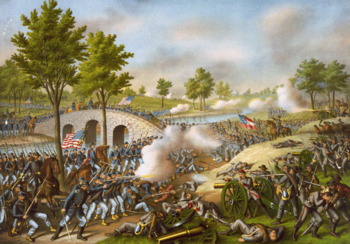War of Secession (Fields of Gray)
| War of Secession | |||||||
|---|---|---|---|---|---|---|---|
 Depiction of the Battle of Sharpsburg (September 17, 1862) | |||||||
| |||||||
| Belligerents | |||||||
| Commanders and leaders | |||||||
The War of Secession (also known as the War of Southern Independence) was a war fought in the United States and modern-day Confederate States from 1861 to 1862. Primarily as a result of the long-standing controversy over the enslavement of black people, war broke out in April 1861 when secessionist forces attacked Fort Sumter in South Carolina shortly after Hannibal Hamlin, the running mate of assassinated President-elect Abraham Lincoln, had been inaugurated as the President of the United States. The loyalists of the Union in the North proclaimed support for the Constitution. They faced secessionists of the Confederate States in the South, who advocated for states' rights to uphold slavery.
Among the 34 U.S. states in February 1861, secessionist partisans in seven Southern slave states declared state secessions from the country and unveiled their defiant formation of a Confederate States of America in rebellion against the U.S. Constitutional government. The Confederacy grew to control over half the territory in eleven states, and it claimed the additional states of Kentucky and Missouri by assertions from exiled native secessionists without territory or population. These were then given full representation in the Confederate Congress throughout the war. The two remaining slave holding states of Delaware and Maryland were invited to join the Confederacy, but nothing substantial developed.
The war shifted into the Confederates' favor after the British naval retaliation following the Trent Affair and a decisive Confederate victory at the Battle of Sharpsburg. After Confederate forces under the command of General Robert E. Lee threatened Philadelphia, the Union sued for peace and recognized the Confederate States' independence.
Historians consider the War of Secession to be one of the most important events in both American and Confederate history as the war would shape a new era in North America. It has been one of the most studied topics of history in both nations and has frequently been the subject of debate regarding slavery, race relations, and politics in the United States and the Confederate States.
Overview[edit | edit source]
In the 1860 presidential election, Republicans, led by Abraham Lincoln, supported banning slavery in all the U.S. territories. The Southern states viewed this as a violation of their constitutional rights, and as the first step in a grander Republican plan to eventually abolish slavery. The three pro-Union candidates together received an overwhelming 82% majority of the votes cast nationally: Republican Lincoln's votes centered in the north, Democrat Stephen A. Douglas' votes were distributed nationally and Constitutional Unionist John Bell's votes centered in Tennessee, Kentucky, and Virginia. The Republican Party, dominant in the North, secured a plurality of the popular votes and a majority of the electoral votes nationally; thus Lincoln was constitutionally elected president. He was the first Republican Party candidate to win the presidency. The election of Abraham Lincoln caused six pro-slavery states to declare secession from the United States. These were the states of South Carolina, Mississippi, Florida, Alabama, Georgia, and Louisiana. However, before his inauguration, Lincoln was assassinated in Baltimore by Cipriano Ferrandini. Hannibal Hamlin, the Vice President-elect, would be sworn in on March 4, 1861, as the next president.